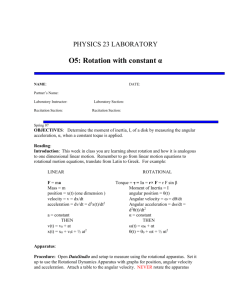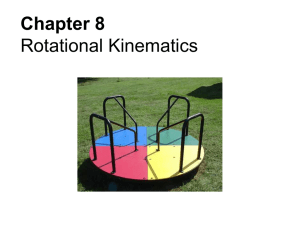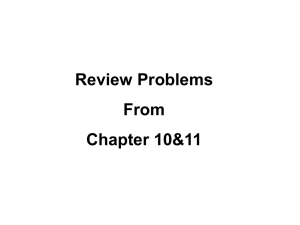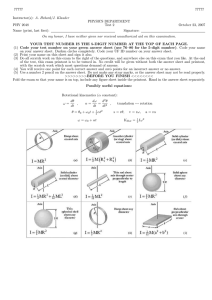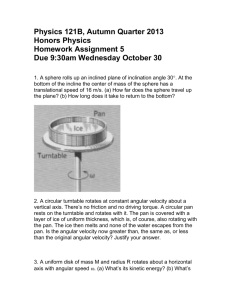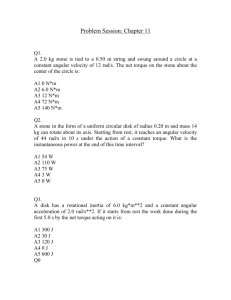77777 Korytov/Sabin PHYSICS DEPARTMENT PHY 2048
advertisement
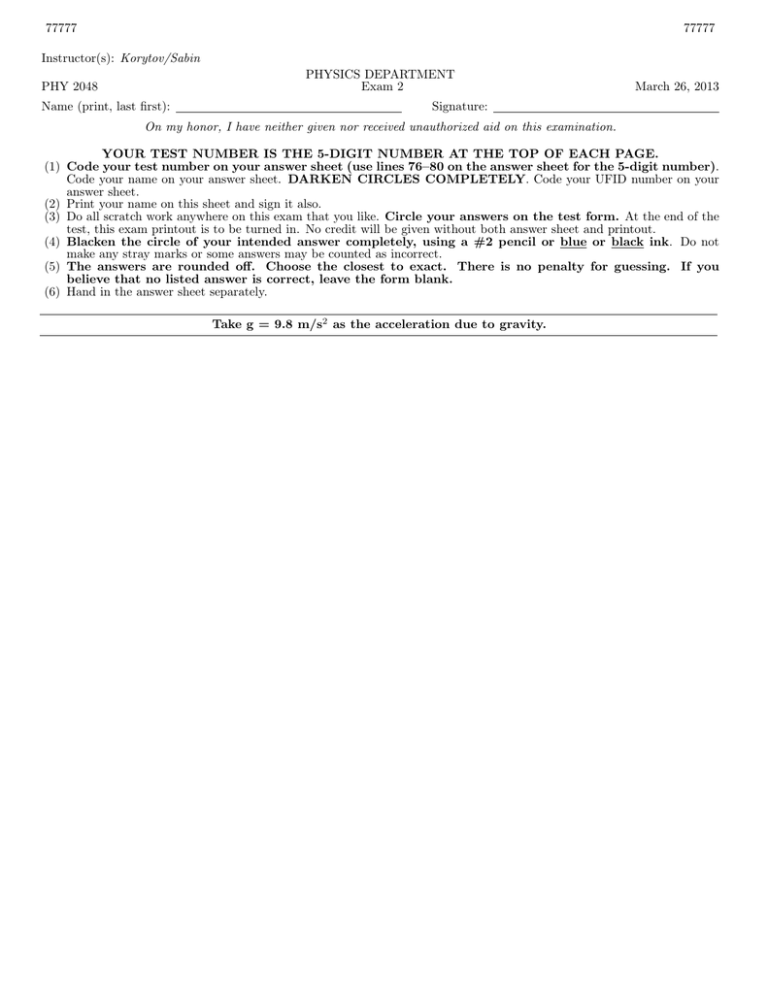
77777 77777 Instructor(s): Korytov/Sabin PHYSICS DEPARTMENT Exam 2 PHY 2048 Name (print, last first): March 26, 2013 Signature: On my honor, I have neither given nor received unauthorized aid on this examination. YOUR TEST NUMBER IS THE 5-DIGIT NUMBER AT THE TOP OF EACH PAGE. (1) Code your test number on your answer sheet (use lines 76–80 on the answer sheet for the 5-digit number). Code your name on your answer sheet. DARKEN CIRCLES COMPLETELY. Code your UFID number on your answer sheet. (2) Print your name on this sheet and sign it also. (3) Do all scratch work anywhere on this exam that you like. Circle your answers on the test form. At the end of the test, this exam printout is to be turned in. No credit will be given without both answer sheet and printout. (4) Blacken the circle of your intended answer completely, using a #2 pencil or blue or black ink. Do not make any stray marks or some answers may be counted as incorrect. (5) The answers are rounded off. Choose the closest to exact. There is no penalty for guessing. If you believe that no listed answer is correct, leave the form blank. (6) Hand in the answer sheet separately. Take g = 9.8 m/s2 as the acceleration due to gravity. 77777 77777 Take g = 9.8 m/s2 as the acceleration due to gravity. 1. A man pushes an 80-N crate a distance of 5.0 m upward along a frictionless slope that makes an angle of 30◦ with the horizontal. The force he exerts is parallel to the slope. If the speed of the crate is constant, then the work done by the man is: (1) 200 J (2) −200 J (3) 61 J (4) 140 J (5) 260 J 2. An ideal spring is hung vertically from the ceiling. When a 2.0-kg mass hangs at rest from it, the spring is extended 6.0 cm. A downward external force is now applied to the mass to extend the spring an additional 10 cm. While the spring is being extended by the force, the work done by the spring is: (1) −3.6 J (2) −3.3 J (3) −3.4 × 10−5 J (4) 3.3 J (5) 3.6 J 3. A Boston Red Sox baseball player catches a ball of mass m that is moving toward him with speed v. While bringing the ball to rest, his hand moves back a distance d. Assuming constant deceleration, the horizontal force exerted on the ball by his hand is: (1) mv 2 /(2d) (2) mv/d (3) mvd (4) mv 2 /d (5) 2mv/d 4. A simple pendulum consists of a 2.0-kg mass attached to a string. It is released from rest at X as shown. Its speed at the lowest point Y is X 1.85 m Y (1) 6.0 m/s (2) 0.90 m/s (3) √ 3.6 m/s (4) 3.6 m/s 5. A small object of mass m starts from rest at the position shown and slides along the frictionless loop-the-loop track of radius R. What is the smallest value of y such that the object will slide without losing contact with the track? (5) 36 m/s m y R (1) R/2 (2) R/4 (3) R (4) 2R 6. As a particle moves along the x axis, it is acted upon by a conservative force. The potential energy is shown as a function of the coordinate x of the particle. Rank the labeled regions according to the magnitude of the force, least to greatest. (5) zero U(x) A (1) BC, AB, CD (2) AB, BC, CD (3) AB, CD, BC (4) BC, CD, AB B C D x (5) CD, BC, AB 7. At the same instant that a 0.50-kg ball is dropped from 25 m above the Earth, a second ball, with a mass of 0.25 kg, is thrown straight upward from the Earth’s surface with an initial velocity of 15 m/s. They move along nearby lines but pass each other without colliding. At the end of 2.0 s, the height above the Earth’s surface of the center of mass of the two-ball system is: (1) 7.1 m (2) 2.9 m (3) 4.0 m (4) 5.0 m (5) 10.4 m 77777 77777 8. Two bodies, A and B, have equal kinetic energies. The mass of A is nine times that of B. The ratio of the momentum of A to that of B is: (1) 3:1 (2) 1:9 (3) 1:3 (4) 1:1 (5) 9:1 9. A 5-ton freight car, moving at 4 mph, collides and couples with an 8-ton freight car, which was initially at rest, The common final speed of these two cars is: (1) 1.54 mph (2) 1 mph (3) 1.31 mph (4) 2.5 mph (5) 4 mph 10. A projectile in flight explodes into several fragments. The total momentum of the fragments immediately after this explosion: (1) (2) (3) (4) (5) is the same as the momentum of the projectile immediately before the explosion. has been changed into kinetic energy of the fragments. is less than the momentum of the projectile immediately before the explosion. is more than the momentum of the projectile immediately before the explosion. has been changed into radiant energy. 11. A wheel starts from rest and has angular acceleration of 4.0 rad/s2 . When it has made 10 rev, its angular velocity is: (in rad/s) (1) 22 (2) 16 (3) 32 (4) 250 (5) 500 12. A wheel starts from rest and has angular acceleration that is given by α(t) = 6t2 . The angle through which it turns in time t is given by: (1) (1/2)t4 (2) (1/8)t4 (3) (1/4)t4 (4) t4 (5) 12 13. A disk with a rotational inertia of 5.0 kg·m2 and a radius of 0.25 m rotates on a frictionless fixed axis perpendicular to the disk and through its center. A force of 2.0 N is applied tangentially to the rim. If the disk starts at rest, then after it has turned through half a revolution, its angular velocity is: (1) 0.80 rad/s (2) 0.57 rad/s (3) 0.64 rad/s (4) 1.6 rad/s (5) 3.2 rad/s 14. A pulley with a radius of 3.0 cm and a rotational inertia of 4.5 × 10−3 kg·m2 is suspended from the ceiling. A rope passes over it with a 2.0-kg block attached to one end and a 4.0-kg block attached to the other. The rope does not slip on the pulley. When the velocity of the heavier block is 2.0 m/s, the total kinetic energy of the pulley and blocks is: (1) 22 J (2) 2.0 J (3) 4.0 J (4) 14 J (5) 28 J ¢ ¡ 15. Two identical disks, with rotational inertia I = 12 M R2 , roll without slipping across a horizontal floor and then up inclines. Disk A rolls up its incline without slipping. On the other hand, disk B rolls up a frictionless incline. Otherwise the inclines are identical. Disk A reaches a height 12 cm above the floor before rolling down again. Disk B reaches a height above the floor of: (1) 8 cm (2) 24 cm (3) 18 cm (4) 12 cm (5) 6 cm 16. A 2.0-kg block starts from rest on the positive x axis 3.0 m from the origin and thereafter has an acceleration given by ~a = 4.0î − 3.0ĵ in m/s2 . At the end of 2.0 s, its angular momentum about the origin is: (1) (−36 kg·m2 /s)k̂ (2) 0 (3) (+48 kg·m2 /s)k̂ (4) (−96 kg·m2 /s)k̂ (5) (+96 kg·m2 /s)k̂ 77777 77777 17. Two disks are mounted on low-friction bearings on a common shaft. The first disk has rotational inertia I and is spinning with angular velocity ω. The second disk has rotational inertia 2I and is spinning in the same direction as the first disk with angular velocity 2ω as shown. The two disks are slowly forced toward each other along the shaft until they couple and have a final common angular velocity of: (1) 5ω/3 √ (2) ω 3 p (3) ω 7/3 (2) 240 N (3) 160 N I 2I (5) 3ω X Y Z (4) 60 N (5) 40 N 19. A 240-N block is suspended as shown. The beam AB is weightless and is hinged to the wall at A. The tension in the cable BC is: (1) (2) (3) (4) (5) 2ω (4) ω 18. A uniform plank is supported by two equal 120-N forces at X and Y, as shown. The support at X is then moved to Z (half-way to the plank center). The supporting force at Y then becomes: (1) 80 N ω C 20 m 12 m 400 N 300 N 320 N 180 N none of these θ = 36.9 B A 16 m 240 N 20. A certain wire stretches 1 cm when a force F is applied to it. The same force is applied to a wire of the same material but with twice the diameter and twice the length. The second wire stretches: (1) 0.5 cm (2) 0.25 cm (3) 1 cm (4) 2 cm (5) 4 cm
